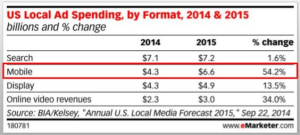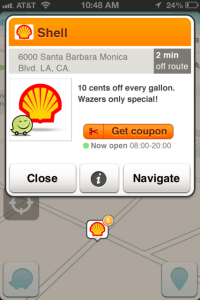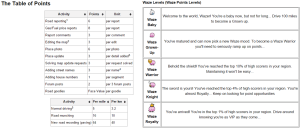Waze: Leveraging the Crowd to Find Your Way

With the help of the crowd, Waze is rapidly enhancing the way we navigate.
Waze is the world’s largest community-based traffic and navigation platform. Now owned by Google, after a $1.3 billion acquisition in 2013, Waze leverages the crowd to help determine the optimal routes for users wanting to travel from point to point.
By using what I’ll call indirect and direct crowdsourcing, the Waze community provides valuable information, allowing the platform to more accurately and efficiently route and re-route users. Specifically, Waze members who use the application indirectly provide the platform with specific GPS, speed, and time stamp information, which provides real-time traffic information. For example, imagine it takes a driver 10 minutes to get from point A to B, assuming the car is traveling 30 miles per hour. If for some reason (e.g., road construction, accident) it takes Waze users a speed-adjusted 45 minutes to reach that point, Waze will take that information and provide either more accurate timing details or alternative routes that allow the user to get from point to point more quickly. In addition to indirect crowdsourcing, Waze has set up its platform to enable direct crowd feedback, as users can report items such as accidents, road construction, presence of police officers, and gas prices on the route (Exhibit 1). These functionalities create significant value for the user, and with direct network effects coming into play, the platform becomes even more useful, as additional users help bring in more real-time data (e.g., announcing when the accident has been cleared).
Exhibit 1. Waze user reporting screen
While creating a lot of value for the users, Waze also creates and captures value from advertisers. The application offers location-based advertising as drivers continue on their route and approach specific listings. A couple weeks ago, while I was driving to section retreat, I actually received an advertisement notifying me that there was a Taco Bell 2 minutes off-route, and if I drove there, I’d receive one free soft taco with my order – pretty amazing. With local ad spending projected by to increase from $6.7 billion in 2015 to $18.2 billion in 2019 (according to BIA/Kelsey), Waze is already positioning itself for success (Exhibit 2). Further, with the help of indirect network effects, as more users adopt the Waze platform, advertisers are more willing to join, which helps boost Waze’s revenue potential. Some might argue that the advertisements may dissuade users from adopting Waze, but my hypothesis is that these ads might actually be great (this is the first time I’ll think advertisements are great) because they are much more relevant (Exhibit 3).
Exhibit 2. Current local ad spending on mobile platforms
Exhibit 3. Shell offering a $0.10 discount off every gallon of gas
So what incentivizes users to participate in the direct reporting? Part of it is the pay-it-forward mentality, and the other part is gamification. With the pay-it-forward mentality, users contribute to the platform because the reports by others have benefited them in the past; there is a huge sense of community. However, Waze also uses gamification via points, rewards, and badges (Exhibit 4) to encourage users to help out. Top Waze reporters are listed on a leader board, and they receive publicly shown badges identifying them across a range of categories from “Waze Baby” to “Waze Royalty”.
Exhibit 4. Waze point system and badges
Although Waze has proven quite useful for consumers and advertisers, the platform has run into some challenges. Recently, police officers have voiced their frustration with Waze for notifying users when there is a patrol car nearby. Police argue that these notifications help criminals target police officers and/or violate speed limits, putting more people at risk. In another example, residential families have been frustrated with Waze redirecting users through their otherwise quiet streets. In both cases, the members have tried to fake reports. Officers have been flooding the database with false police locations, and small neighborhood families have been faking accidents on their streets to fool Waze. While these actions do hurt the value of the platform, Waze spokeswoman Julie Mossler points out that, “Users who have made the most accurate reports have higher-ranked reports—the info that they send in is more trusted by the app’s algorithm. Should a fake accident appear on your map, it’ll be cleared within minutes when the app refreshes…” Therefore, while some users may have personal motivations to inhibit Waze’s performance, the crowd seems to work well to protect the application’s integrity.
I think Waze is doing an excellent job at leveraging the crowd, and I’m excited to see what’s in store for them in the coming future.
Sources:
http://www.businessinsider.com/police-officers-vs-waze-google-traffic-crowdsourcing-app-2015-2
http://www.fastcompany.com/3040172/are-la-residents-faking-accidents-to-fool-waze







Awesome post! I’m curious if Waze extracts more value from the direct or indirect crowdsourcing. The indirect crowdsourcing isn’t all that different from what Google Maps does for traffic, so I would assume the direct crowdsourcing provides the differentiation. That said, this direct crowdsourcing typically requires an active driver to be playing around on their phone. Waze “attempts” to prevent this by launching a popup and requiring the user to confirm they are a passenger and not a driver, yet they benefit each time a driver breaks the law and adds traffic and accident info. I imagine it’s not difficult to determine how often a Waze user is involved in an accident. I wonder what, if anything, Google could and should do with this information and if there is a way to make Waze use safer.
Obviously, one of the greatest Israeli innovations 🙂 I found it amazing how the use of crowds helped building a data base of maps that usually it really expensive to build and maintain. This is what enabled Waze to maintain their start-up mode and agile resources.
Turning the crowd to into your asset is the key.
Thank you for the amazing post! I agree completely that Waze has leveraged direct crowd sourcing to take on Google Maps which was primarily relying on indirect crowd. The fact that Google has paid huge dollars inspite of having a leading platform them-self points to the strengths of Waze. Waze has a better direct crowd sourcing platform while Google Maps has a better indirect crowd sourcing platform (atleast personally I feel that way when using the two products). It will be interesting to see how that changes going forward. So far, Google has kept Waze as a separate platform but given what we know about direct and indirect networks it works better for them if they can migrate all the users onto a single platform because it will add much more value to all the users. However, integrating them might not be a simple task for Google. Less from the technology point of view, but more from the customers point of view who might be put off by any significant changes as they merge the two. And more broadly it will be interesting to see how the different cultures at the firms operate if Google does integrate the product. Though it’s more a question of when they will integrate than if they will integrate (going back to the benefits from network effects)
Great post!!
Waze was able to build active community of users through the gamification, as you mentioned, and also by community managers. When Waze enters a new city, it creates a huge marketing campaign and organizes conferences where it invites users to take an active part of building the maps.
Big part of the map building happens through Waze’s map editor, and not through the drivers’ instant reports. The real question is whether the users who edit the maps, would be incentivized to do so for Google maps.